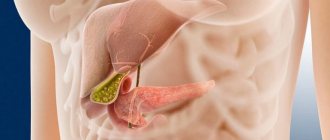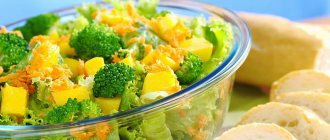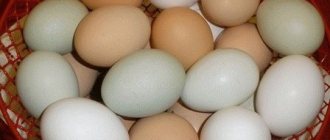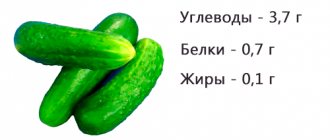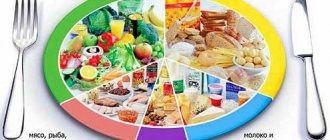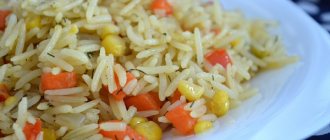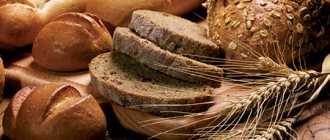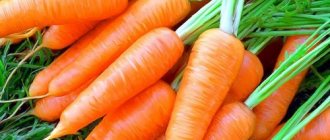Fish dishes
Preference is given to fresh fish.
Since many varieties are difficult to find fresh on store shelves, you have to purchase a frozen carcass. This method of preserving freshness is acceptable for storage. It is important to ensure that the freezing process is carried out only once. When re-frozen, the beneficial properties are lost, the product takes on a different appearance, and the taste changes. To avoid buying such a low-quality product, follow some rules:
- The surface of the carcass does not change color. If there is a yellowish coating, feel free to refuse the purchase.
- They prefer dry freezing. With repeated defrosting, the product loses its shape and becomes deformed. When re-freezing, all the drained moisture turns into ice and snow. This will be evidenced by a large number of fish around.
- When re-freezing, the layer of ice lies unevenly.
It is allowed to cook only from fish fillets. Pay special attention to preparation. The carcass is thoroughly washed, scaled, skinned, all bones and entrails are removed, and the fleshy part is separated. This ingredient will become the basis for preparing many dishes.
The most common dish in the diet is preparing lean fish soup for pancreatitis. The prepared fillet is cut into slices, filled with purified water, and boiled in a saucepan. Remove the foam, add potatoes (diced), carrots, onions. Cook everything until tender, at the end add finely chopped greens and add a little salt.
steamed dumplings
Steamed dumplings will be a tender finished product, which is safe to eat if you have pancreatitis.
The prepared fillet of skinny fish is ground in a blender into minced meat along with a small onion, a slice of cracker (dipped in skim milk), and an egg is added. All ingredients are mixed with the addition of a pinch of salt. Using spoons, form dumplings, place them in a steamer tray, and cook.
A dietary fish soufflé for pancreatitis will brighten up the patient’s menu. The finished fillet is boiled or cooked in a double boiler, ground in a blender until smooth, combined with beaten egg whites, chopped carrots, and a uniform piece of bread with milk. All ingredients are mixed and filled into molds. Bake in the oven, but it is better to use a double boiler.
Low-fat fish: cod, pike perch, pike, navaga, carp, bream, etc.
Fish dishes that meet the requirements of diet therapy for chronic pancreatitis: quenelles, soufflé, boiled fish, meatballs.
The transition from diet No. 5p to diet No. 5 is carried out with the permission of the attending physician. The assortment of fish dishes can be supplemented with:
- Baked fish balls with cottage cheese (belip)
- Fish pudding, option 2
- Fish poached in milk
- Fish casserole
- Fish meatballs
Ingredients:
- Low-fat fish (for example, pike perch) - 120 g
- rice - 15 g
- butter - 5 g
- water - 50 g
Cooking technology:
- Cook the rice into a viscous porridge and cool.
- Add porridge to the pike perch fillet and mince it twice.
- Add 5 g of melted melted butter.
- Beat well, make meatballs and steam.
Ingredients:
- Low-fat fish (for example, cod) - 200 g
- parsley -10 g
For the sauce:
- decoction - 100 g
- wheat flour - 10 g (1 tsp)
- egg - 1/2 pcs
- Clean the cod, cut it into portions and boil it in salted water with parsley.
- Dry the flour without oil in a frying pan and dilute with fish broth. Boil for 5 minutes
- Place a finely chopped hard-boiled egg into the broth.
- Place the cod on a plate and pour the sauce over it.
Ingredients:
- pollock, (maybe pike) - 320 g
- egg - 1 piece
- vegetable oil - 20 g (2 tsp)
- bread - 60 g.
- We cook the fish - wash it, remove the bones and skin, cut it into pieces and pass it through a meat grinder.
- Add bread soaked in water and mince again
- Add the egg and salt and mix thoroughly.
- We form meatballs weighing 20-25 g from minced meat.
- Cook the meatballs in water.
- Serve fish balls by pouring melted butter over them.
Ingredients:
- cod – 240 g
- milk - 100 g (1/2 cup)
- carrots - 10 g
- vegetable oil - 10 g (1 tsp)
- wheat flour - 10 g (1 tsp)
- Prepare the sauce: dry the flour in a frying pan without adding oil. Gradually add hot milk to the flour, add salt and a little vegetable oil (preferably olive oil)
- We wash the fish, cut it into portions and put it in a saucepan.
- Chop the carrots on a coarse grater and add to the fish. Salt.
- Let the fish and carrots simmer in a small amount of water for 10-15 minutes.
- Place on a baking sheet greased with vegetable oil. Fill with sauce. Bake in the oven until done
Ingredients:
- Low-fat fish (for example, perch) - 340 g
- sour cream 15% -20 g (1 tbsp)
- wheat flour - 10 g (1 tsp)
- vegetable broth for sauce - 100 g
- oil - 7 g
- Wash the perch well, peel and cut into portions. Put it in a saucepan.
- Add roots - carrots and parsley.
- Fill with cold water so that the fish is covered 3/4 with water and simmer for 10 minutes.
- Place the fish on a baking sheet and pour in sour cream sauce. Bake in the oven.
Boiled pike perch
Ingredients:
- Low-fat fish (for example, pike perch) - 100 g
- sour cream, greens and parsley root - 5 g each
- Cut the prepared fish into pieces and place in a saucepan. Fill with cold water, bring to a boil and skim off the foam.
- Add greens and parsley root, salt and cook for 10 minutes
Fish dumplings, recipe - read here
Boiled fish dumplings from pike perch, recipe - read here
Fish soup puree, recipe - read here
For pancreatitis, eating fresh fish is very useful, however, properly selected fresh frozen fish can also be used to prepare dietary and tasty dishes. If the patient's disease is in the acute phase of its course, it is better to use the fish after getting rid of the skin. Your diet should include both fish fillets and whole fish.
Fish can be used to prepare cutlets, quenelles, soufflés, meatballs, broths, meatballs, and casseroles.
Steamed fish cutlets
You should take about 500 g of fish fillet, 2 eggs, 100 g of butter, 3 tbsp. l. semolina, 1 onion, salt. The fish, butter and onion are pre-chopped, the semolina is mixed with eggs and all the ingredients are combined. The minced meat should be homogeneous. You need to form the minced meat into cutlets, place them in a double boiler or multicooker, selecting the steam cooking mode. You can also cook the cutlets in the oven.
Dietary fish with Polish sauce
You need to take 200 g of cod, 10 g of parsley, 1 tsp. l. wheat flour and 1 egg. The cleaned fish is divided into small pieces, boiled, adding parsley to the water, keeping in mind that the broth must be saved for preparing the sauce. Dry the flour in a frying pan and dilute with fish sauce, boil for 5 minutes. A hard-boiled, finely chopped egg is added to the broth. The resulting sauce is seasoned with cod laid out on a saucer.
Fish with sour cream sauce
You need to take 300 g of perch, 1 tbsp. l. sour cream (15% fat), 1 tsp. l. wheat flour, 1 carrot, parsley root, 100 g vegetable broth, 10 g butter.
The washed fish, divided into pieces, should be placed in a saucepan, adding chopped parsley root, carrots and pouring cold water, ensuring that the fish pieces are ¾ covered. Cook the dish over low heat for 10 minutes.
To prepare the dish you need to take 120 g of fish, 15 g of rice, 5 g of butter, 50 g of water. You need to prepare a viscous porridge from the rice and cool it. Porridge is added to the pike perch fillet and the resulting mass is passed through a meat grinder twice, adding 5g of melted butter to the composition. The minced meat is well beaten, formed into round balls and steamed.
Fish in milk sauce
It is recommended to use cod (240g) for preparing the dish. You also need to take 100 ml of milk, 10 g of carrots, 10 g of vegetable oil (it is better to use olive oil), 10 g of wheat flour.
Preparing the dish begins by preparing the sauce. Dry the flour in a frying pan without adding oil, gradually introducing hot milk into the flour, adding salt and olive oil. Place the washed and cut fish in a saucepan, add finely chopped carrots, salt, pour in a small amount of milk, and leave for 15 minutes. Then put the contents of the saucepan on a baking sheet greased with vegetable oil, pour in the sauce and bake in the oven.
The nutritional system for pancreatitis does not include the consumption of heavy and fatty foods. Nutritionists and gastroenterologists recommend following a special diet and diet. According to these recommendations, it is necessary to exclude foods that are harmful to health from the diet. In case of inflammation of the pancreas, you should eat mainly protein foods, and it is better to reduce the consumption of fats and carbohydrates to a minimum.
Both in acute pancreatitis and in exacerbation of the chronic form of the disease, the patient is prescribed a special gentle diet. According to this diet, the use of low-fat fish plays an important role in the diet. The product has a rich composition and, while following a special nutritional system, replenishes the lack of nutrients in the body.
You need to include fish in your diet 7 days after an attack of pancreatitis. For the acute form, fish fillets are used, without skin; for chronic pancreatitis, it is allowed to use fish meat without chopping, in whole pieces in a properly processed form, which means preparing steamed fish dishes, in ovens, and also in baked form.
In most cases, patients are prescribed treatment table number 5. This nutritional system is used at any stage of the development of pancreatitis, both in case of relapse and during remission of the disease. Treatment table number 5 includes the use of low-fat varieties of river and sea fish. The product is an important component of a specially designed menu.
Fish soup recipes
For the dietary menu during the treatment of pancreatitis, recipes for first courses from lean fish are suitable: cod, pollock, pike perch, flounder. Such soups contain a large amount of protein necessary for the normal functioning of the body.
Ingredients:
- 1 carcass of lean fish;
- two tablespoons of millet;
- 2 potatoes;
- about 50 grams of green peas;
- 1 carrot;
- 2–2.5 liters of water;
- salt;
- greenery.
Recipe:
- The potatoes are peeled and cut into cubes.
- Grate the carrots.
- Pre-prepared fish is cut into large pieces.
- Place millet and vegetables into boiling water. Boil for about 10 minutes, then add fish.
- When the vegetables are almost ready, add green peas, salt, finely chopped dill and parsley.
- Leave to simmer over low heat for another 5 minutes.
This soup can be prepared from any lean fish. The introduction of new vegetables or cereals into the recipe will allow you to diversify the taste.
Often, dishes made from vegetables soon become boring, which is why recipes for soups for pancreatitis are made from fish.
hake fish soup
- hake – 500 gr.;
- milk – 75 g;
- flour – 2 tablespoons;
- butter – 3 large spoons;
- bulb;
- potatoes – 2 pcs.;
- salt;
- greenery.
Place the hake in the water and set it to cook. When boiling, remove fat and foam. Place shredded potatoes in a container. Separately simmer the onion and place it in a cauldron with the fish. We also add herbs and season with salt. Grind the prepared mass, add milk and boil for 2 minutes.
Allowed fish
To determine what kind of fish patients with pancreatitis can and should eat, they look at the fat content percentage. It should be minimal. Such types do not overload the diseased organ, do not cause complications, and do not provoke unpleasant symptoms. Dishes made from these ingredients are suitable for consumption in acute and chronic forms of the disease.
fish allowed for pancreatitis
Among the allowed fish, there are 2 groups:
- dietary;
- with moderate fat content.
In the first group, the fat content does not exceed 4%. This figure may be lower, for example, marine species (only 1%). Among these low-fat dietary fish varieties for pancreatitis are:
- river perch and blue whiting;
- cod and navaga;
- pollock and lemonema;
- pollock and haddock.
The listed varieties are related to lean varieties with 1% fat content.
There is also a list of low-fat fish species, their list consists of varieties with 3% fat content, which is also acceptable for pancreatitis:
- carp and pike perch;
- flounder and pike;
- mullet and crucian carp;
- roaches and lampreys;
- white-eye and burbot;
- whitefish and grenadier;
- grayling and sorog.
This food is eaten during an exacerbation of the disease. It is used to prepare mousses, steam cutlets, cook lean soups, and make delicate soufflés. What other fish can you eat if you have pancreatitis? Only lean, but the percentage will increase to 4%:
- pagrus and rudd;
- ice fish and mackerel;
- greenling and carp;
- trout and halibut;
- hake and sea bass.
The percentage of fat depends on the age of the individual and the time when it was caught (winter, summer). It has been established that in winter and autumn this figure is significantly higher than at other times of the year.
Be sure to consult a doctor. The doctor will examine the patient and conduct laboratory tests. If the patient's condition is positive, expand the diet. This includes fish with low fat content. The maximum amount of fat is no more than 8%:
- sole and anchovies;
- ide and carp;
- tuna and catfish;
- mackerel and red-eye;
- silverfish and smelt;
- carp and pink salmon;
- catfish and chum salmon;
- bream.
During a period of acute illness, these delicacies should not be eaten. Be sure to choose a gentle cooking method. Fried foods are being replaced by steamed, stewed, boiled, and baked dishes.
Acute pancreatitis
Is it possible or not to eat herring for acute pancreatitis? With this form of pathology, as well as with an attack of chronic inflammation, you cannot eat salted herring. This ban is explained by the following aspects:
Although fish is considered low-fat, there is no stable percentage of fat content and it usually ranges from 0 to 33%. That is, “by eye” you will not be able to choose a less fatty fish. During a relapse, when absolute fasting is indicated on the first day, and the most gentle nutrition on the subsequent days, any food containing animal fats is strictly prohibited. This precaution is explained by the fact that they activate the production of enzymes, which can lead to a deterioration in the condition of the parenchymal gland.
The second aspect is salt. In case of pancreatitis, this food product should be consumed in very small quantities, and during attacks it should be completely excluded from meals for 2 weeks.
Only after a month, with positive test results, the patient’s well-being and the persistent disappearance of the relapse clinic, is it possible to eat a piece of steamed herring.
Unfortunately, depending on the type, tasty herring is considered a fatty or moderately fatty fish. And animal fats are powerful stimulators of the secretory ability of the pancreas. After eating herring, pancreatic juice begins to be actively produced. But its enzymes are not included in the labor-intensive process of breaking down nutrients, but aggravate the existing acute inflammation and damage to the gland. As a result, pain and other manifestations of a terrible disease increase.
You can decide to eat a piece of herring only after acute pancreatitis is completely over and you feel completely well.
Video on the topic:
Fish for pancreatitis and cholecystitis
In the acute course of pancreatitis, painful sensations are recorded in combination with symptoms of intoxication. Cholecystitis is a serious inflammatory disease of the gallbladder, which leads to stagnation of bile and the formation of stones. It occurs most often due to poor nutrition. Diet therapy for these pathologies has an important role; it promotes the active restoration of impaired organ functions and accelerates the recovery process.
Fish is a healthy and nutritious product that can be included in the diet for both pancreatitis and cholecystitis. The product, thanks to its composition rich in vitamins and microelements, helps supply the body with necessary substances without overloading the affected digestive system. It is necessary to use low-fat varieties of fish, from which you need to prepare boiled, stewed, baked dishes, thus diversifying the menu.
Why are the incidence rates of pancreatitis increasing every decade?
Because disruption of the pancreas is caused by disruption of the liver and gallbladder!!!
And they are becoming more common due to environmental degradation and increasingly chemicalized food. First, hepatocytes begin to suffer from external and internal toxins. But the liver and pancreas have a common bile duct, through which bile with altered properties can enter it, causing the activation of pancreatic enzymes directly in it. It's like it's self-digesting. This process is especially pronounced when the bile has been altered for a long time and gallstones have already formed.
Forbidden fish
Despite the beneficial qualities of red fish, use during the period of illness with pancreatitis is strictly prohibited. In addition to the vitamin complex, useful elements, it is enriched with fats in large quantities. As a result, there is an exacerbation of symptoms, among which are:
- nausea;
- vomiting;
- dizziness;
- weakness, malaise;
- pain in the abdominal cavity;
- stool disorders (fatty discharge, characterized by undigested fat, is noted in the stool).
ban on smoked fish
In addition to fatty fish, the pancreatic organ does not accept some methods of preparing fish for pancreatitis. The delicate mucous membrane of the pancreas undergoes irritation and inflammation. Any aggressive food can cause irreparable harm to the digestive system and lead to consequences. Which fish should you avoid?
- Salted, fried, dried. Aggressive food provokes strong production of enzymes for digestion and absorption. The result is irritated pancreatic mucosa, exacerbation of the inflammatory process, possible swelling, suppuration, necrosis.
- Smoked. All smoked foods are very harmful to the entire digestive system.
- High in fat.
In addition to fatty fish, it is forbidden to eat any low-fat varieties for pancreatitis, when it comes to canned food. Many people mistakenly believe that this type of delicacy is allowed to be included in the patient’s menu. They like to make soups from them or eat the product in its pure form. This is strictly prohibited. They contain a rich amount of harmful additives in the form of emulsifiers, dyes, preservatives, flavor enhancers and other components.
The role of soups in the patient’s diet
During treatment of pancreatitis, it is recommended to completely avoid fatty, spicy and fried foods.
Also contraindicated are dishes that are difficult to digest or cause gas formation in the intestines. With such restrictions, dietary soups will help make the daily menu more varied and tasty. They are easily digestible, do not burden the digestive system and saturate the body with useful elements.
It is also worth noting that first courses activate the production of gastric juice, due to which less load is placed on the pancreas.
How to buy and cook fish for pancreatitis
If it is not possible to purchase fresh fish, you need to buy and use fresh frozen fish. It is important to pay attention that the product does not have a yellow coating or a large layer of ice. The selected fish must be thoroughly cleaned of scales, entrails and bones, and rinsed.
You can introduce fish dishes into your diet after an exacerbation, weeks after the attack. During this period, you should only consume types with minimal fat content, which are baked, boiled or stewed. The first days it is better to steam it, using only twisted fillets, cleared of bones and skin. After a week, you can gradually start baking or stewing, preferably in ground form, but you can do it in small pieces.
A fish dish cooked in the oven, steamer or slow cooker is considered healthy. Fish prepared in this way retains a large amount of useful substances in its composition and is easily digested.
Instructions for use
It is not recommended to forget that Omega-3, like any other active substance, in addition to its beneficial properties, also has certain contraindications. That is why, before purchasing a dietary supplement containing PUFAs at a pharmacy, you must consult a specialist and carefully read the instructions for the drug.
How should you take a drug containing a large amount of Omega-3 fatty acids for pancreatitis? There is nothing complicated about this, you just need to remember the following tips and follow them:
- The daily amount of a dietary supplement should not exceed 5–10 grams in liquid form or 2–3 capsules. An increase in dosage provokes a deterioration in the functioning of the damaged digestive organ.
- The course of treatment is 21 days. Only on the recommendation of a doctor, depending on the stage of development of the disease, it is increased to three months.
- In the first days, while the body gets used to it, the dosage of the drug is no more than 5 milliliters, and if even mild discomfort occurs, it is necessary to stop using the dietary supplement.
And it is also not recommended to take it if the negative signs of pancreatitis increase - belching and nausea, indicating that the drug is not absorbed by the body. In this case, you can get the Omega-3 acids necessary to stop the inflammatory process in the pancreas from sea fish of medium fat content. It is preferable to steam dishes from it.
Fish oil is used in combination with other drugs and treatment methods to prevent atherosclerosis of the lower extremities (read about treatment with folk remedies here).
Drink 1-3 capsules three times daily.
The best time to take it is after eating, with water.
The course of treatment is 1-3 months, after which they donate blood for analysis and repeat the course if the results require it.
If you have cholecystitis or pancreatitis, you should not take fish oil. It should not be used in parallel with fibrates or oral anticoagulants.
The drug is contraindicated if you have recently had surgery or been injured: it will be difficult to stop the bleeding. Individual intolerance to individual components also forces you to refuse to take the product.
It is better to refuse the product if:
- gallstones,
- urolithiasis disease,
- pathology of the thyroid gland (the use of white cinquefoil is written about in this article).
Despite the fact that scientists recognize the benefits of consuming fish oil during pregnancy and lactation, it is advisable to consult a doctor before starting use.
In case of overdose, symptoms of exacerbation of pancreatitis and cholecystitis are observed. The drug should be stopped.
Fish oil capsules should be stored in a dark, dry place where the temperature is kept at 15-25 degrees. Keep away from children.
The medicine is a yellowish homogeneous mass.
Additional substances used in production:
- gelatin,
- glycerol,
- sometimes the composition is supplemented with vitamin E for preservation purposes.
Fish fat
Patients are interested in whether it is possible to include fish oil in the menu for pancreatitis? At the time of developing pancreatitis of the pancreas, the work of digestion and assimilation of food becomes difficult. All of it is carefully selected by nutritionists in favor of healthy lean foods.
Fish oil is a product that enters the body undiluted. It makes it difficult for the affected organ to work and causes complications. The use of this component during the period of exacerbation of the disease is prohibited. Take in small doses and with caution for stable disease.
fish oil
There are many contraindications for consuming fish oil for pancreatitis and cholecystitis:
- Hypersensitivity or individual intolerance.
- Low blood clotting.
- Hemophilia.
- Chronic kidney failure.
- Problems in the endocrine system.
If a period of exacerbation is considered, the answer is no. In case of stable remission, it is permissible to use this product in moderate quantities.
Consumption of fish oil for pancreatitis is acceptable within acceptable limits. Monitor the calories of the food you eat. When consuming this component, the consumption of vegetable or butter is reduced by the same amount. Only a doctor can authorize and set the volume of fat consumption. Contact him for advice and a detailed treatment plan.
Fish oil is considered a substance beneficial to the body. However, if you have problems with the pancreas, its use is strictly prohibited, since the breakdown of fish oil requires enzymes that are not synthesized by the inflamed pancreas.
Diet chicken soup
People who have suffered acute pancreatitis need to adhere to a strict diet for some time. Patients with a chronic form of the disease need to follow a diet constantly.
In this case, you should adhere to the following recommendations:
- First courses cannot be prepared from young chicken meat.
- It is advisable to use chicken fillet; it does not contain skin, tendons or fat.
- Cook the meat for at least 20 minutes, then drain the broth and pour clean water over the meat. Continue cooking for about half an hour. You can prepare first courses for such an illness only with a second broth.
- The finished broth is salted and herbs are added to it, sometimes seasoned with sour cream. For soup, vegetables or cereals are added to it.
There are many recipes for first courses for patients with inflammation of the pancreas. But not all may be suitable for a particular patient, because the course of the disease and the presence of exacerbations must be taken into account. It is advisable to consult a doctor who monitors nutrition; you cannot deviate from the diet without his permission. This is especially true for cream and milk, which are allowed only to a few.
People diagnosed with pancreatitis must maintain a healthy diet for the rest of their lives. But this does not mean that a person will have to limit himself in everything and eat not tasty. There are recipes for dietary dishes for pancreatitis that are quite simple to prepare and yet incredibly tasty.
Recipes for pancreatitis are gentle. They contain a maximum of useful substances and vitamins, make the diet varied and rich, and do not overload the digestive organs.
It is better to ask your doctor what recipes you can use for pancreatitis, because some dishes are prohibited during an exacerbation of the disease.
Contraindications
Eating fish is not recommended if the body is hypersensitive to fish or fish oil. It is not recommended to use fish if you have poor blood clotting, chronic kidney pathologies, acute cholecystitis, hemophilia, or endocrine system disorders (thyroid dysfunction). Fish should not be consumed if you have high blood pressure or in the early postoperative period.
A woman with pancreatitis during pregnancy should limit the use of fish to prevent indigestion, which is expressed by loose stools.
Acceptable consumption rate for illness
As already noted, with an exacerbation of the chronic form of pancreatic pathology against the background of cholecystitis or other provoking factors, as well as with the acute nature of the disease, eating herring is prohibited.
But, with stable remission, up to 300 grams of herring per week is allowed, preferably boiled or steamed.
The presence of herring in the diet during inflammation of the pancreas depends on the exact stage of the disease and the presence or absence of relapse.
Acceptability and portion of fish - depending on the phase and type of disease:
- Acute pancreatitis is not recommended.
- Chronic inflammation - during exacerbation, use is prohibited. In case of stable remission, boiled or steamed fish is allowed in the amount of 300 grams per week. In this case, one serving of fish product should not exceed 100 grams.
Useful properties of fish
The beneficial properties of fish meat and dishes prepared from it are determined by its composition. The product is rich in:
- Omega acids. These are semi-saturated fatty acids that are necessary for the normal functioning of fat metabolism;
- Proteins. The substance is quickly absorbed by the body;
- Fat-soluble vitamins (D, A, C, PP, H, E B vitamins). Other foods contain these vitamins in minimal quantities;
- Iodine, phosphorus, iron, selenium and other trace elements. Substances are necessary for the normal functioning of all organ systems. Marine fish contains such elements in large quantities.
Fish saturates the body with fatty acids: linoleic and archidonic acids (the famous omega 3 and omega 6), they are part of the brain cells and are the building material for cell membranes. Omega 6 and omega 3 reduce the level of bad cholesterol in the blood, normalize the digestive process, and reduce the risk of developing atherosclerosis.
The significant phosphorus content in fish has a beneficial effect on the functioning of the nervous system and increases performance. For the endocrine system, in particular, for the successful functioning of the thyroid gland, iodine, which is rich in sea fish, is extremely useful.
How to take natural remedies according to the Sokolinsky System
The result of observing people who took various natural remedies for the pancreas was the Active Pancreatitis Complex for 2 months
It contains four 100% natural and safe for your health products and this takes the protection of the organ and the support of its work to an incomparably greater physiological depth than simply replacing missing enzymes.
What we do: we eliminate the cause of tissue damage: we normalize the structure of bile and its free secretion in response to food intake. In order for bile to restore its normal properties and stop “terrorizing” pancreatic cells, we support the organ that produces it - i.e. liver.
Fish for exacerbation of pancreatitis
After the attack has stopped, the patient is prescribed therapeutic fasting, and later various foods, including fish, are gradually introduced into the menu. Fish dishes can be consumed no earlier than a week after the start of a strict diet. Dishes to prepare in the first days of the diet: steamed minced fish, boiled fillet, ground fish, stewed fillet, chopped into tiny pieces.
For acute pancreatitis, you should choose fish varieties that contain a minimum percentage of fat. These species include river and sea bass, cod, navaga, Argentine salmon, pink salmon, limonema, pelengas, pike, mimogi, blue whiting, omul varieties and carp.
Fish for pancreatitis is an important component of a special diet. The correct choice and heat treatment of the product allows you to supply the body with useful substances, diversify the menu, and prevent relapses of a serious disease.
Herring for acute illness
Herring is often eaten salted, which allows not only to preserve the beneficial properties of the product, but also to extend its shelf life. In salted form, in acute forms of pancreatitis, when a relapse occurs, consuming the dish in question is prohibited. Salted herring is not beneficial, but on the contrary, contributes to the development of the inflammatory process, so it is better to exclude it from the menu until remission.
In case of exacerbation of pancreatitis, eating herring is allowed only if this product is boiled. The product belongs to the category of low-fat products, but even in this case it is recommended to abandon the dish during the relapse of inflammation. You can resort to eating seafood no earlier than a month after the exacerbation has passed. Moreover, it is important to steam the dish. It is recommended to replace the consumption of meat with fish, as it contains a larger number of useful components that are quickly and well absorbed.


